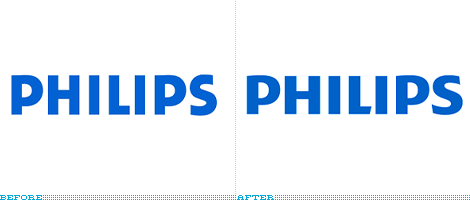
In stealth mode, one of the largest manufacturers of all sorts of electronic paraphernalia, Philips, updated its wordmark. (For those wondering, yes, we are a little late to the party on this one; the change took place a couple of months ago, so I apologize for the non-breaking news aspect of this). The changes are almost unnoticeable, specially to the end-user, which would make anyone skeptical about the need for a change at all. But considering the immense amount of consumer and specialty products that Philips produces, I doubt this was merely a superficial, aesthetic change to satisfy some C-level executive’s whim. All the modifications point to a need for better performance and reproducibility.
Continue reading this entry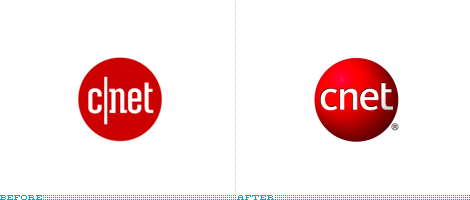
One of the bastions of Web 1.0, 13-year-old CNET is getting a significant makeover. While the workings under the hood of the new web site like a “new API that is helping to deliver pages 40 to 50 percent faster” means nothing to me, we can certainly focus on the front-end changes, specifically the logo. Originally named and written c/net (for Computer Network) it is now an all caps CNET, making the logo in all lowercase a little contradicting, but who can argue against the friendliness of lowercase? The new logo is being referred to as the “pipeless” logo, so I’m guessing that the vertical line in the old one was meant to signify a, um, pipe — but like no one should call New York “The Big Apple” I’m going out on a limb and say that no one refers to the internet delivery system as a “Pipe”. But I digress. [Update: See Patrick Foster’s comment]. The typography in the old logo was peculiar and quirky, with the weird “n” and tight letterspacing making it somewhat engaging and memorable, while the new one is painfully generic and forgettable. And while everybody knows that this is pronounced see-net, the lack of a visual divider certainly renders the new logo as knet. Oh, yes, it now has a shadow to make it look like a sphere. Yay.
Thanks to Moeed Mohammad, Fred Sotherland and Greg for the tip.
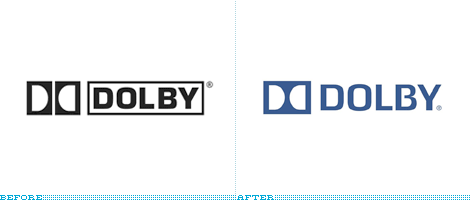
Update July 8, 2008: Roberto Landazuri, Corporate Archivist for Dolby was kind enough to contact us and provide some corrections and further insights into the background information we received about this logo from Turner Duckworth. Landazuri noted that the original logo was created in 1967 or 1968 by the graphic design partner of a two-man advertising shop in Surrey. The designer is quoted as saying “[Dr. Dolby] explained in simple terms that sounds were directed down a funnel and emerged from an inverted funnel as a cleaner, clearer sound. It was then that the initial idea of the Double ‘D’ came to me, thus making two double funnels. I returned to my studio and finally submitted three designs on my original idea. He immediately chose my first idea, saying ‘That says it all.’” According to Ray Dolby, this is the specific conceptual underpinning for the original logo: the complementary nature of the Dolby noise reduction process. We were also informed by Landazuri that Ray mentioned that there is, coincidentally, a secondary significance to the double Ds: The two Dolby brothers, Ray and Dale, who cofounded the company in 1965.
Having grown up around media that included the presence of the Dolby logo — as I’m sure many of us have — I now recall that my impression of the double-d logo lead me to believe they had something to do with general tape and reel-to-reel technology, given the cassette-like look of the logo. My impression was likely not rooted in corporate intention as the original logo was designed by the founder, Ray Dolby, and had no specific conceptual underpinning. Either way the double-d has become a rather ubiquitous fixture in modern media environments, having successfully made the recent transition into the digital world. While we continue to see the presence of “Dolby Digital” in and around the movies, their brand presence with the stroked rectangle around “DOLBY” and uncomfortably justified “DIGITAL” has seemed a bit stale for a company that is trying to continue to define high-quality and audio surround sound. Enter Turner Duckworth, with their experienced touch and attention to brand and collateral details we have a refined update to the logo and respective visual identity system that retains the brand equity Dolby has established.
Continue reading this entry![]()
Not even a mysterious J.J. Abrams movie trailer can create this much speculation and bemusement. Last week, for no apparent reason whatsoever, Google changed its favicon from the uppercase “G” of its logo to its lowercase “g”. And the blogs have gone crazy. Which is probably the whole point of the change: Demonstrating how a minute change for the most ubiquitous web site can have enormous ripples. It’s like the ultimate chest thumping. They didn’t change the logo, they didn’t change the home page, they didn’t change the results page, they didn’t change the ooooooo’s. They just changed a sixteen-pixel square and created a stir. Now that’s branding.
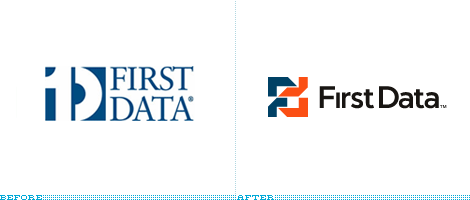
Unfortunately I have nothing to reference or go by for this redesign. (According to this blog post, it’s feasible that Chicago-based VSA Partners did the work — given that First Data has been a client of them since 2001, and the logo is indeed VSA-ish, I would jump on board and agree.) Fortunately, it’s great enough on its own that we can talk about it. First Data is one of those complex companies that make things behind the scenes work flawlessly through mind-bending systems, fancy computers and, surely, some type of mathematical equations. Or, in their words, “First Data processes transaction data of all kinds, harnesses the power of that data, and delivers innovations in secure infrastructure, intelligence and insight for its customers.” What it boils down to is technology, data, and getting it from one place to another — the new logo manages to convey all this and more. The interlocked “F” and “d” signal connectivity and interaction, while the hard-angled shapes convey that this is a technologically astute company that — instead of softening its image like the rest of the rounded identities (xerox, docomo, kodak) — isn’t afraid to communicate that it’s authoritative and hard-nosed. The old logo was a heartwarming play on visuals and language, but felt decidedly vintage. If there is one major complaint I have about the new logo is the annihilation of the dot over the “i.” Sure, it solves the boinking of it against the “F” but I just find this continued practice of de-dotting to be wrong. Nonetheless, In contrast to the remarkable new modern-day monogram introduced by First Data, it’s a small quibble. First Data could transfer my data any day of the week.
Thanks to Joe Szczepaniak and Rachid Molinary for the tip.
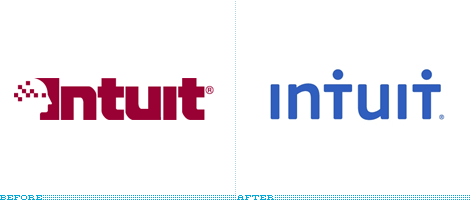
I can’t stand the thought of taxes or administrative tasks — it’s not that I’m above it or that I am too creative to be bothered by them, I just get confused easily — but it is with fond memory that I remember Intuit’s TurboTax software that allowed me to file my very first 1040EZ form for my 1999 taxes when I originally moved to the U.S., a daunting task made significantly easy, even with that old android dude of a logo sticking its pixelated head out of the side of the box. Earlier this month, Intuit unveiled (internally) a new logo that replaces the android with a more broadly humanized representation of, well, humans.
Continue reading this entry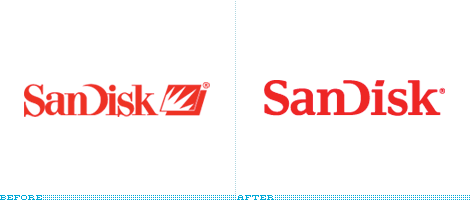
Brett Wickens, Vice President and Executive Creative Director at MetaDesign (and of former Ceramic Hello fame) has been kind enough to provide us with some valuable insights into their recent redesign of SanDisk, the world’s leading supplier of innovative flash memory data storage products.
Continue reading this entryApologies for any inconvenience the insane amount of spam may be causing. These attacks usually last two or three days, but this one has been going on for over two weeks now. I try to clean it up as efficiently as possible. If I pump up the volume on my spam filters some of your comments will get banned, so unfortunately I can’t be harsher in that respect. I appreciate your patience and I hope this goes away soon.
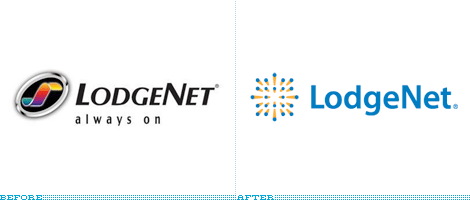
Jerry Kuyper (of recent Cisco redesign fame), alongwith brand strategy firm Group 1066, has created a new graphic identity for LodgeNet Interactive Corp. — best for you to read what they do as it’s impossible to condense in a simple sentence. As this is an example of an effective corporate redesign by one of the field’s most talented designers, I asked Jerry if he would share some of his first-hand insights into the project and its respective process — and he kindly accepted.
Continue reading this entry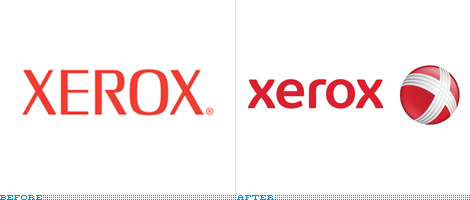
Whatever you do, whether it’s today or 1994, please do not call Xerox “the copier company”. Actually, don’t call it “The Document Company” anymore either. While you are at it, don’t confuse Fuji with Xerox, or wonder if the two merged. And, finally, please forget about that pixelated X that became one of the best known and widely recognized icons. All that is a thing of the past. Yes, just the past four decades. Poor Xerox, so misunderstood, so verbalized — “Can you xerox this for me? Thanks intern” — so outdated. Yet, if you worked anywhere with one of those multi-tasking, short of coffee-making machines, you know that Xerox can do more (way more) than make black and white copies of your spreadsheets. Yet, apparently, few people realize this. And nothing cures ailments like these better than a rebranding. Unveiled today, the new identity, designed by Interbrand, for Xerox may signal a new era for the company but, as far as we designers are concerned, it merely signals the full embrace of the senseless threedimensionalization of the corporate world.
Continue reading this entryPrevious Page | Next Page
(Total Number of Pages in Technology: 3)


















